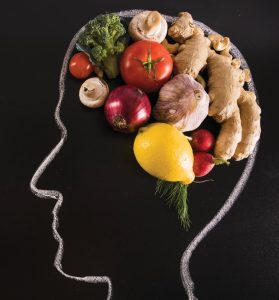A Nourishing Nutrition Mindset
Author: Jenny Bradley
 Have you ever started thinking about a luscious bright yellow lemon that’s being freshly cut? Note the texture of the lemon’s skin and how juice runs down the side as the knife runs through the light yellow pulp. Imagine the aroma as you bring the slice of lemon to your nose to inhale the fresh citrus fruit. Then, bring the slice to your lips and bite into the lemon, enjoying the tart juice. Did your mouth begin to salivate? The mind is a powerful thing, even when it comes to food and what we choose to eat. Your thoughts about that food induce a physiological effect in your body.
Have you ever started thinking about a luscious bright yellow lemon that’s being freshly cut? Note the texture of the lemon’s skin and how juice runs down the side as the knife runs through the light yellow pulp. Imagine the aroma as you bring the slice of lemon to your nose to inhale the fresh citrus fruit. Then, bring the slice to your lips and bite into the lemon, enjoying the tart juice. Did your mouth begin to salivate? The mind is a powerful thing, even when it comes to food and what we choose to eat. Your thoughts about that food induce a physiological effect in your body.
The most significant stimulants to our diet and digestion are seeing, smelling, and tasting food. Otherwise referred to as the cephalic phase of digestion. The cephalic phase triggers saliva, digestive enzymes, and an increase in heart rate, all to help your body process the incoming components of what you are about to eat or drink. Just like how our mind starts our digestive process before we touch food, our mind also informs how we perceive our relationship with food.
Many of us connected with practitioners, like those at Riordan Clinic, live with chronic illness or disease that our clinical team gives evidence-based nutritional recommendations for. Some of the recommendations are easier to apply than others. The ease of upgrading our diet can sway based on our perceptions of the foods we are told to avoid or include. Sometimes we need our minds to help us out a little more. Sometimes a reframing of terms or ideas can be helpful.
In America, we’ve been conditioned to think the word diet means food restriction to lose weight. What if, instead, we choose the definition to be about what we intentionally consume, focusing less on restriction and more on what we thoughtfully include that’s designed to fuel our bodies for full function. We can refine our thoughts to focus on intentional nourishing nutrition and less about stopping our hunger cues with whatever is nearby.
Nourishing well involves making whole-food meals full of fiber, healthy fats, sensible carbohydrates, and quality protein. (Note: Follow the guidance of your practitioner who knows your personal case.) Choosing whole foods from the Earth that don’t have additional ingredients is a great starting point when planning a meal. We can limit or omit things that may induce inflammation, such as gluten, dairy, refined sugar, high fructose corn syrup, and inflammatory oils like canola, vegetable, peanut, and corn oil. We can also avoid ingredients that contribute to our body’s toxic burden, such as artificial ingredients, sweeteners, and colors.
Instead, choose options such as unsweetened coconut milk and cream, organic nut milk, hemp seed milk, organic oat or soy milk, maple syrup, honey, coconut sugar, pure avocado oil, coconut oil, ghee, and olive oil. In addition, there are all kinds of different gluten-free flours available that can be used instead of wheat flour. A quick internet search can give you those details. And don’t forget about fresh herbs and spices for flavor!
Sometimes we need to experience how much better we can feel after intentionally nourishing ourselves with nutrient-dense whole-food meals. These meals support our bodies rather than instigate discomfort, digestive issues, skin irritations, joint pain, headaches, fatigue, and more.
As we learn what foods are more beneficial to our healing, we can choose them more quickly and intentionally. And just like our minds give our bodies cues when we think of cutting a juicy lemon, so too can our thoughts help us towards choosing foods that truly nourish, support, and fuel our cells.
REFERENCES
- Brandt, Claus et “Food Perception Primes Hepatic ER Homeostasis via Melanocor- tin-Dependent Control of mTOR Activation.” Cell vol. 175,5 (2018): 1321-1335.e20. doi:10.1016/j.cell.2018.10.015
- Kobylewski, Sarah, and Michael F “Toxicology of food dyes.” International Journal of Occupational and Environmental Health vol. 18,3 (2012): 220-46. doi:10.1179/1077352512Z.00000000034
- Glushakova, Olena et “Fructose Induces the Inflammatory Molecule ICAM-1 in Endothelial Cells.” Journal of the American Society of Nephrology : JASN vol. 19,9 (2008): 1712-20. doi:10.1681/ASN.2007121304
- Aeberli, Isabelle et “Low to moderate sugar-sweetened beverage consumption impairs glucose and lipid metabolism and promotes inflammation in healthy young men: a randomized controlled trial.” The American journal of clinical nutrition vol. 94,2 (2011):479-85. doi:10.3945/ajcn.111.013540
- de Lorgeril, , Salen, P. “New insights into the health effects of dietary saturated and omega-6 and omega-3 polyunsaturated fatty acids.” BMC Med 10, 50 (2012). https://- doi.org/10.1186/1741-7015-10-50





